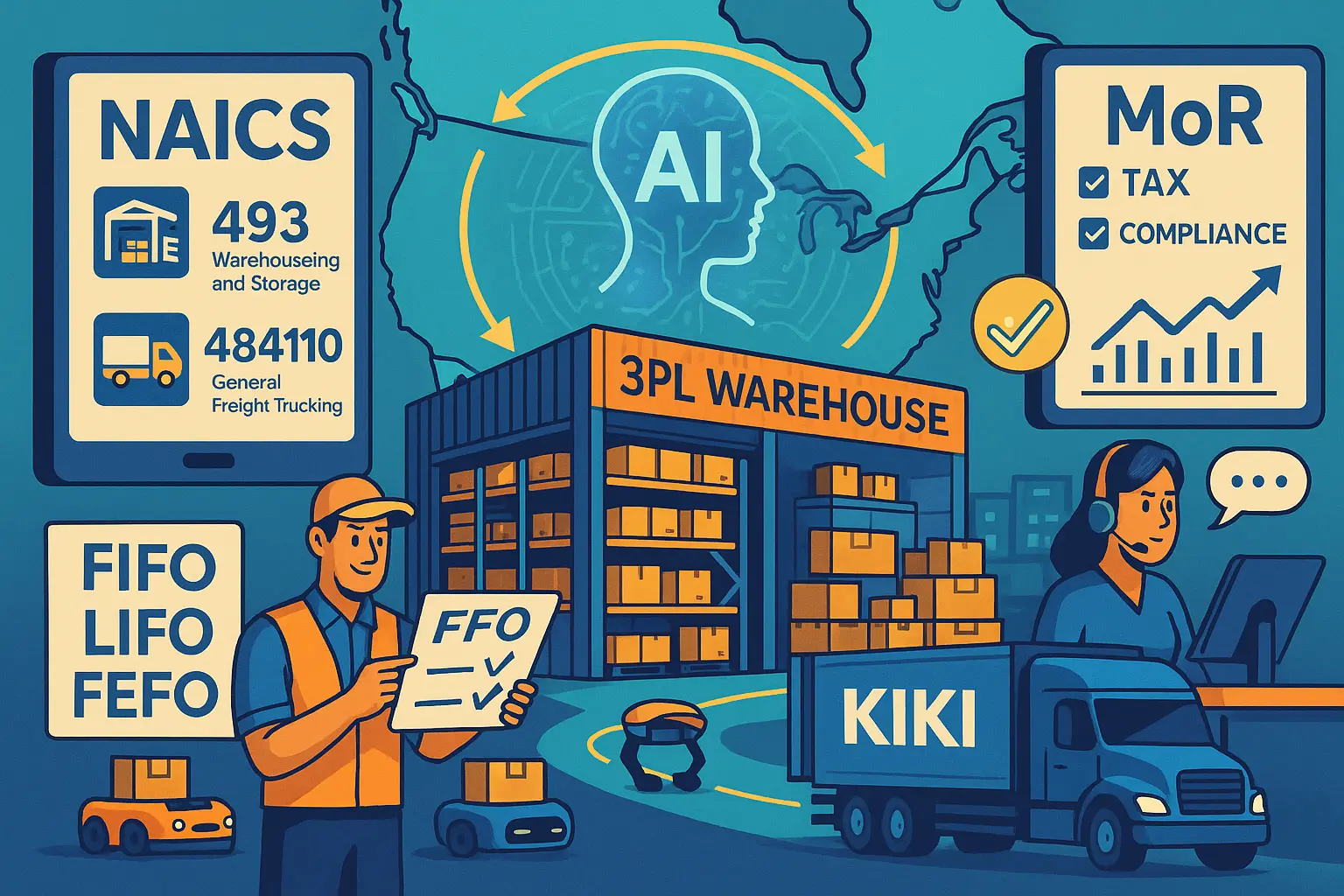
Retail supply chains in North America are more complex than ever. With rising consumer demand, cross-border friction, and ever-changing regulations, managing fulfillment and compliance has become a full-time job. For many brands, especially those expanding across Mexico, the U.S., and Canada, one overlooked detail can cause massive inefficiencies: incorrect NAICS classification.
NAICS—the North American Industry Classification System—is more than just a six-digit label. It determines your legal positioning, tax liabilities, and eligibility for regulatory programs. When combined with Merchant of Record (MoR) services, AI-driven 3PL logistics, and proper inventory models like FIFO or FEFO, NAICS compliance becomes a strategic advantage.
In this guide, we explore how to integrate all these layers—NAICS, MoR, 3PL, and AI—to build a frictionless, scalable retail logistics framework across North America.
What Is NAICS and Why Logistics Operators Should Care
NAICS codes help governments and institutions categorize economic activity. In logistics, relevant codes like 493 (Warehousing and Storage) and 484110 (General Freight Trucking) impact how your operations are taxed, audited, and regulated.
Misclassification could mean missed incentives, delays at customs, or fines during inspections. Worse, it complicates inventory flow reporting and restricts access to integrated supply chain financing models.
If your logistics partner isn’t aligning with the right NAICS codes, your entire operation could be vulnerable
NAICS Meets MoR: The New Compliance Standard
A Merchant of Record (MoR) is not just a billing entity—it becomes the legal face of your operation. It handles taxes, customer payments, and ensures regulatory compliance. When MoR is combined with 3PL logistics, your supply chain benefits in four ways:
- Accurate NAICS Registration – MoR ensures your business is properly classified from the start.
- Integrated Fulfillment Flow – From customs handling to cross-border transport, everything is documented under the right industry code.
- Tax Reporting Compliance – Correct classification streamlines VAT, sales tax, and import/export documentation.
- E-Commerce and Physical Goods Harmony – MoR bridges your online and offline logistics with unified records and reporting.
This alignment allows for smarter decision-making, lower regulatory risk, and smoother scaling across LATAM and North America.
Inventory Models That Match the New Supply Chain
If you’re still using only FIFO (First In, First Out) or LIFO (Last In, First Out) without AI support, you’re running blind.
Here’s how modern inventory strategies align with different product types:
- FIFO: Best for high-turn goods and general retail (e.g., apparel, gadgets)
- LIFO: Useful for maximizing tax efficiency in inflationary environments
- FEFO: Critical for perishables, supplements, cosmetics, and healthcare products
Smart fulfillment platforms, like those used by Kiki LATAM, integrate all three models and apply them based on SKU classification, shelf life, and NAICS code relevance.
AI Logistics: The Engine Behind Smart Supply Chains
Artificial Intelligence is transforming every aspect of logistics. When integrated with NAICS logic and MoR infrastructure, AI delivers:
- Predictive Inventory Optimization – AI forecasts product demand and expiration rates based on historical performance and market conditions.
- Automated FIFO/FEFO Sorting – Expiry-sensitive products are prioritized in real-time for dispatch.
- Smart Routing & Delivery Windows – AI helps plan last-mile delivery based on NAICS sub-sectors (e.g., food, pharma, electronics).
- Compliance-Ready Reporting – All movement is tagged and traceable, aligned with your registered activity under NAICS.
This allows retail operators to reduce waste, minimize stockouts, and ensure that every delivery—across borders or cities—is optimized and documented.
A Step-by-Step Framework to Align NAICS, MoR, and 3PL
- Identify Your NAICS Code
Use Census NAICS Lookup or tools like NAICS.com to classify your operation based on service scope (warehousing, freight, etc.). - Engage a MoR Partner
MoR simplifies tax obligations and allows cross-border payments without legal entanglements in each country. - Select a 3PL with AI-Driven Inventory Systems
Ensure they support FIFO, LIFO, and FEFO based on your SKUs and that they integrate your NAICS code logic into operations. - Implement AI-Based Tracking and Route Management
Smart logistics tools reduce emissions, improve ETAs, and adapt to different NAICS subcategories. - Measure Performance Across Key Metrics
- NAICS alignment compliance
- Fulfillment accuracy
- Inventory aging and waste
- Cross-border delivery success
- Chain-of-custody visibility
How Kiki LATAM Helps You Get It Right
At Kiki LATAM, we provide a full-stack logistics ecosystem aligned with NAICS, integrated with MoR functionality, and powered by AI.
MoR Services – We handle compliance, invoicing, tax, and sales operations for retail companies scaling in the U.S., Mexico, and Canada.
AI Logistics Platform – From inventory automation to last-mile route planning.
NAICS-Aligned Fulfillment – Our logistics hubs in Colombia, Mexico, Peru, and the U.S. operate with clear regulatory classification.
FIFO, FEFO, LIFO Capabilities – Applied based on product type, expiry risk, and tax strategy.
Getting your logistics classification right isn’t just a paperwork exercise—it’s the first move in optimizing your entire retail operation. When you align NAICS, MoR, and AI-powered fulfillment, you unlock a new level of visibility, tax efficiency, and scale.
Kiki LATAM helps retail brands and logistics leaders simplify the complex—so they can focus on growth, not paperwork.
👉 Contact us to align your NAICS code, streamline your inventory model, and scale across North America with confidence.
